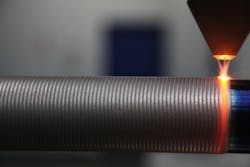EAST GRANBY, CT – American Cladding Technologies was recently confronted with the challenge of laser cladding the endcap of a 14-ft.-long, laser-clad carbon steel soot blower tube (FIGURE). These soot blower lances are used in a boiler system for a waste-to-energy power producer, where tubes are subjected to highly corrosive conditions. This lance was too long to clad in the typical horizontal position, so the company developed a program and process to clad the endcap in the vertical configuration. The cladding material is a multi-blend of different alloys, essentially nickel-based, and the build-up is 0.040 in.
The customer was replacing one lance per month—now, they’re replacing it every six months. Alternative processes are tungsten inert gas (TIG) and metal inert gas (MIG) welding with Inconel overlay, but advantages in using laser cladding are low dilution, thinner coatings (because dilution is controlled), lower heat input, higher-quality metallurgical bond, less stress, and shorter process times.
American Cladding Technologies’ laser cladding processes have extended the life of boiler tubes for the waste-to-energy industry up to five years without failure. The company specializes in innovative laser cladding solutions for the power generation, aerospace, and chemical processing industries, as well as for valves, pumps, and industrial gas turbines.
For more information, please visit www.americancladding.com.

David Belforte | Contributing Editor
David Belforte (1932-2023) was an internationally recognized authority on industrial laser materials processing and had been actively involved in this technology for more than 50 years. His consulting business, Belforte Associates, served clients interested in advanced manufacturing applications. David held degrees in Chemistry and Production Technology from Northeastern University (Boston, MA). As a researcher, he conducted basic studies in material synthesis for high-temperature applications and held increasingly important positions with companies involved with high-technology materials processing. He co-founded a company that introduced several firsts in advanced welding technology and equipment. David's career in lasers started with the commercialization of the first industrial solid-state laser and a compact CO2 laser for sheet-metal cutting. For several years, he led the development of very high power CO2 lasers for welding and surface treating applications. In addition to consulting, David was the Founder and Editor-in-Chief of Industrial Laser Solutions magazine (1986-2022) and contributed to other laser publications, including Laser Focus World. He retired from Laser Focus World in late June 2022.
